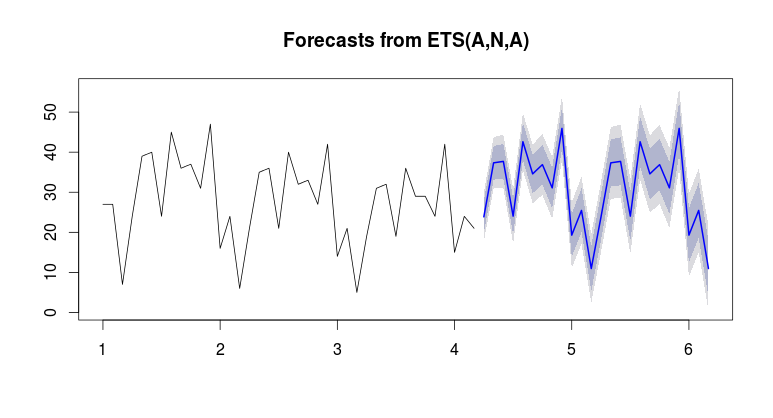I am working on an alogorithm in R to automatize a monthly forecast calculation. I am using, among others, the ets() function from the forecast package to calculate forecast. It is working very well.
Unfortunately, for some specific time series, the result I get is weird.
Please, find below the code i am using :
train_ts<- ts(values, frequency=12)
fit2<-ets(train_ts, model="ZZZ", damped=TRUE, alpha=NULL, beta=NULL, gamma=NULL,
phi=NULL, additive.only=FALSE, lambda=TRUE,
lower=c(0.0001,0.0001,0.0001,0.8),upper=c(0.9999,0.9999,0.9999,0.98),
opt.crit=c("lik","amse","mse","sigma","mae"), nmse=3,
bounds=c("both","usual","admissible"), ic=c("aicc","aic","bic"),
restrict=TRUE)
ets <- forecast(fit2,h=forecasthorizon,method ='ets')
Please, you will find below the concerned history data set :
values <- c(27, 27, 7, 24, 39, 40, 24, 45, 36, 37, 31, 47, 16, 24, 6, 21,
35, 36, 21, 40, 32, 33, 27, 42, 14, 21, 5, 19, 31, 32, 19, 36,
29, 29, 24, 42, 15, 24, 21)
Here, on the graph, you will see the historical data (black), the fitted value (green) and the forecast(blue). The forecast is definitely not in lines with the fitted value.
Do you have any idea on how to "bound" the forecat to be "in line" with the historical sales?


 Note the increase in the level at the end of the series.
Note the increase in the level at the end of the series.

 The final model's statistics are here
The final model's statistics are here  The Actual/Fit and Forecast graph is interesting as it highlights the exceptional activity.
The Actual/Fit and Forecast graph is interesting as it highlights the exceptional activity. 
ets. The mean/level of the historical data is around 20 and the mean/level of the forecast is around 50. Not sure why this would happen ? can you run a basicetsand see if you get the same results ? $\endgroup$